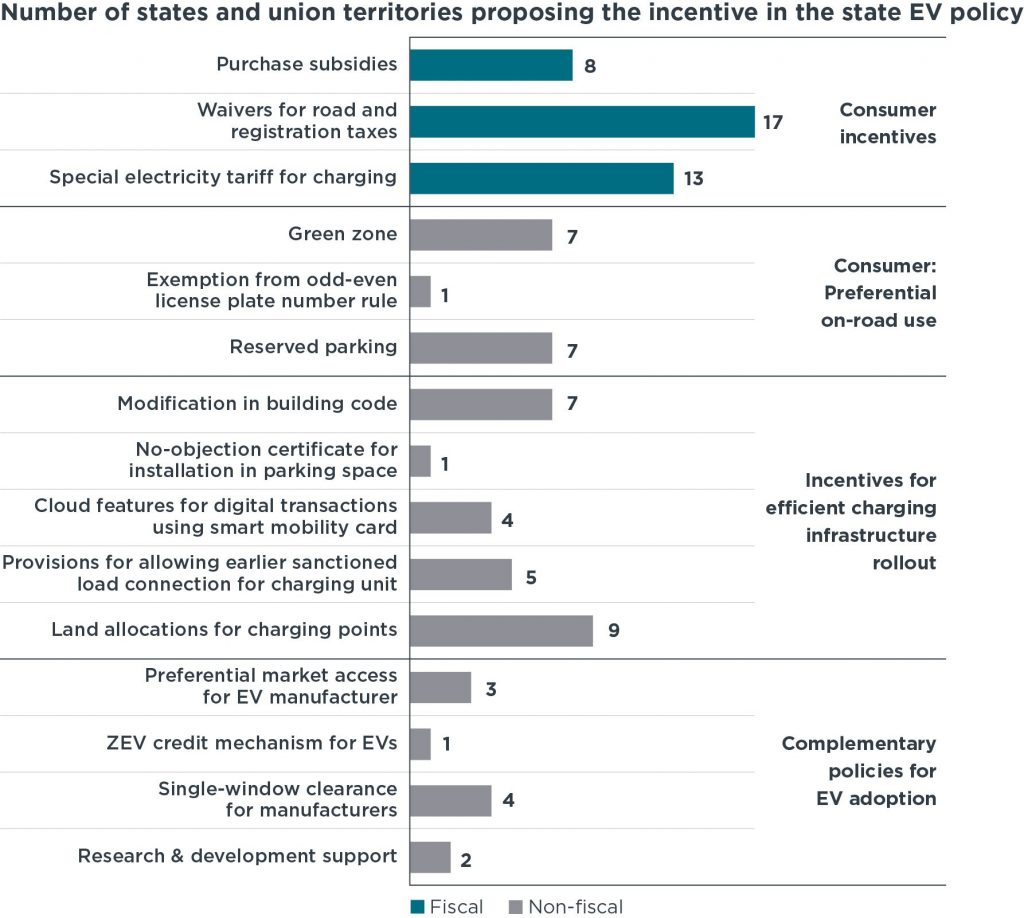By Sunitha Anup, Researcher, The International Council on Clean Transportation
India’s road sector is responsible for 90 percent of carbon dioxide emissions from transportation and the widespread adoption of electric vehicles (EVs) is a key measure to reduce these emissions. While fiscal incentives like tax credits and subsidies have been shown to aid in promoting EV adoption, non-fiscal incentives can also help lower barriers and encourage consumers to switch from conventional vehicles to EVs. Late last year, at an IEA training, I gave a talk about non-fiscal incentives in India and I’ll cover some of the highlights here.
First, our recent study shed light on the use and proposed use of non-fiscal incentives to promote EVs across Indian states and union territories up to September 2022. We compared this with fiscal incentives and, as illustrated in the chart below, found that most states have prioritized fiscal incentives over non-fiscal measures. Additionally, the only states that have proposed more than three non-fiscal incentives are Maharashtra and West Bengal—both have four non-fiscal incentives in their state EV policies. Between the two states, Maharashtra focuses more on policies that give EV drivers preferential status on the road than West Bengal.

Maharashtra is worth dwelling on because it ranked second in India in terms of EV ownership (absolute number of vehicles across all segments) as of September 2023. The state’s efforts to deploy public charging stations were also evident in another recent ICCT study, which found Maharashtra topped all states and union territories in India in terms of public electric vehicle supply equipment (EVSE) stock. Maharashtra has proposed the following incentives:
- Creation of green zones
- Reserved parking for EVs
- Incentives for efficient charging infrastructure rollouts like digital transactions for mobility cards to aid EV users
- Allocation of public land for charging points
Like Maharashtra, West Bengal has proposed creating green zones and incentivizing efficient charging roll-out strategies like mobility cards for EV users. It also suggests modifications in the building code for provisioning of EV charge stations in both private and commercial buildings; this would be incorporated as amendments for existing buildings and is also applicable to new buildings.
By complementing fiscal initiatives with non-fiscal incentives, policymakers could expect a variety of benefits that are grouped into a few broad categories below. Non-fiscal incentives can help to:
Enhance the likelihood of realizing the environmental benefits of EVs. When heavily polluting combustion engines are prevented from operating in a green zone, this bestows a privilege upon EV owners. Through such measures, governments and local authorities both reduce local pollution and create a sense of exclusivity and convenience for EV owners that can make the transition away from combustion vehicles more appealing.
Support infrastructure development. Charging infrastructure is a critical component of widespread EV adoption. Governments can offer incentives to businesses and property owners to establish charging stations. Additionally, facilitating the installation of a charging network through strategies like issuing no-objection certificates in parking spaces, making public land available for charging, and organizing tenders can help stimulate the market for charging infrastructure. This ultimately benefits EV owners.
Improve public awareness and understanding. Non-fiscal incentives can involve disseminating accurate information and promoting EV-related initiatives that help consumers make informed decisions and dispel uncertainties about the vehicles. Governments and civil society organizations can launch campaigns, workshops, and events to showcase the advantages of EVs, dispel myths, and address concerns about things like battery life during extreme weather, fire safety, range anxiety, and maintenance needs. For example, the Go Electric campaign was launched by the Ministry of Power and led by the Bureau of Energy Efficiency in February 2021; it created awareness of the consumer benefits of EVs at the national level and boosted the confidence of EV manufacturers and consumers alike.
Foster collaboration and partnerships. This happens among stakeholders including automakers, utility companies, and local governments. By incentivizing EV partnerships, governments can encourage the development of innovative solutions such as vehicle-to-grid technology and smart charging systems. These collaborations can accelerate the growth of the EV market and provide consumers with enhanced features like advanced battery technology, improved safety, and services like wireless EV charging and seamless payment options. There is also the opportunity to share promising strategies for battery recycling and best practices for closing the loop of battery utilization.
The states and union territories in India that have not yet focused on non-fiscal incentives in their EV policies have a good opportunity to look at the benefits described here. Fortunately for the climate and public health, there’s evidence that more are paying attention recently. Jharkhand notified an EV policy in October 2022 that provides lane and parking preferences to EVs. In November 2022, Manipur released a new electric mobility policy that includes reserved areas in tourism spots where the state is to provide transport services in an environmentally friendly manner by exclusively using EVs.
Also, in a new EV policy that Tamil Nadu released in February 2023, the government is to declare six cities as EV cities. In each of these a small mobility program will be designed with a focus on EVs, and the program is to prepare a roadmap that includes the electrification of three-wheelers and buses in phases over 10 years.
Similarly, Uttar Pradesh released EV manufacturing and mobility policy in November 2022. Green routes are to be identified in each district by 2025 and there are to be electric buses on each of these routes. Urban local bodies may identify spaces for reserved parking in public lots that contain EV charging.
Non-fiscal measures such as the ones I discussed here can offer important benefits in the long run by supporting the EV transition. Policymakers in India and elsewhere would do well to consider steps to adopt them.

